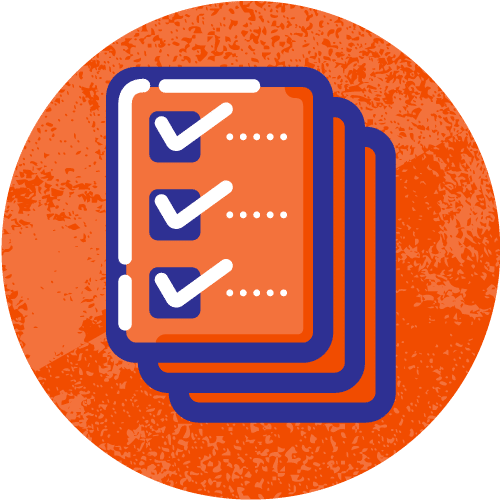Agency owners often ask me whether to focus on custom services, productized services, or a combination of both.
The answer? It depends on your unique Values, Goals, and Resources (VGR)… but your decision is easier when you know the pros & cons of each option.
Are you currently thinking about changing from custom to productized, from productized to custom, or to a combo of both? Be careful—your choice impacts almost everything about your agency. That includes marketing and sales; project management and delivery; and even how fast you get paid.
Here, I’ll review the pros & cons of each approach (custom vs. productized vs. both). I’ll also share behind-the-scenes from my own experience offering both kinds of services as an agency consultant.
In a future article, I’ll share my step-by-step process for deciding which approach is right for your agency. Be sure you’re getting my email newsletter for agency leaders, so you don’t miss any updates.
The Pros & Cons of Custom Services
In their early days, most agencies are delivering custom services—a unique strategy and/or “build” for each client. The work tends to be complex—but it’s profitable if you do it right. But that’s often a big “if.”
Pros: Custom Services
- Higher fees: Custom services help you justify charging higher fees. For instance, a non-custom website would typically be $20-35K… but a custom website could easily be $100K+, depending on the client.
- More-sophisticated clients: With the higher price point—and higher need for customization—your clients will tend to be more sophisticated. Many agencies prefer working with professional marketers, versus clients who are juggling a million tasks as a small business owner.
- Pride in your work: When you succeed in “shipping” a complex project or a challenging month in a retainer, you and your team can take pride in a job well done. You worked hard, and it paid off.
- Get paid for everything you do: Because you’re regularly negotiating the scope of your work (whether via Milestone pricing or something more flexible), it’s easier to get paid for extras because clients tend to assume that you’re building much of their custom work from scratch.
- Time-saving via “semi-custom” services: You can automate back-end processes (via templates, standard modules, software libraries, and more) to give clients a nearly-custom experience… without needing to build everything from scratch. This can be a win-win; clients get the customization they need, and your team can work faster.
Cons: Custom Services
- Slower sales process: It takes time to scope-out the complex custom work, especially if you’re working using Milestone pricing. It’s all the more painful when you create a custom scope for a client who doesn’t move forward. Doing a Paid Discovery process can reduce your cost-of-sale, but it doesn’t eliminate future scoping entirely.
- Higher client expectations: Clients expect a lot from agencies doing custom work, including extra tweaks to get things “just right.” This can lead to scope creep, with seemingly endless out-of-scope negotiation. Sometimes clients don’t understand why something seemingly simple would be so expensive.
- Complex project management and fulfillment processes: Plan on investing more in account management (AM) and project management (PM) to handle your custom-oriented enterprise clients. Your PMs need to be more than “work babysitters.” And the “know just enough” baseline for your AMs will be higher than on productized services.
- Expensive labor: When you do custom services, everyone’s more expensive. That includes subject matter experts (SMEs), project managers, account managers, and salespeople. For instance, you need the $150K+ salesperson or lead developer, not the salesperson working on a $60K base or an entry-level developer straight from a coding bootcamp. You’re also more likely to need additional senior people to mentor and oversee the junior people.
- Slower payments, if clients dispute the scope: I worked with an agency where an unhappy client withheld payment… which nearly put the agency of business. (One solution: Structure the scope to put revisions at the beginning of the next milestone, not at the end of the current milestone.)
The Pros & Cons of Productized Services
After tiring of “custom each time” services, many agencies consider delivering a productized service—that is, clients get a limited range of options rather than anything they want. You might charge less, but productized work can be profitable… if you get the cost structure right.
Pros: Productized Services
- Marketing is easier: Since you aren’t trying to sell anything to anyone, you can narrow your marketing. As “productized” implies, you’re selling a service that’s closer to an off-the-shelf product rather than a custom service. You might compare your marketing to a SaaS firm, rather than a consulting firm.
- The sales process is easier: It’s easier to build a “fast fail” sales process, because a high percentage of prospects will “fail out” early. It helps that your marketing is straightforward; many prospects will skip reaching out altogether. And scoping is easier, since you’re typically pulling “standard” prices from a library of estimates.
- Standardized delivery process: Your team is likely to work more smoothly on productized services, because they’re repeating the same basic process over and over again. This can translate to economies of scale and other automation opportunities. The delivery “flowchart” is simpler than for a custom service.
- SMEs may be able to self-manage: When the work is less complex, you may not need dedicated project managers—or at least may not need as many PMs.
- Theoretically cheaper labor: You get what you pay for, but you can likely staff a more-junior team than a fully custom shop. (You’ll still need some senior people to provide mentorship and oversight.)
- Easier to profitably deliver recurring-revenue services: When it’s (roughly) the same thing each month, your team can “wash, rinse, and repeat.” This is easier in productized services, versus “bespoke each month” custom services.
- Easier to get paid faster: Because productized clients tend to have a clearer picture of the deliverables they’ll get, there tend to be fewer “done vs. ‘almost done‘” disputes. The definition of “done” tends to be less ambiguous, which means you can get paid faster.
Cons: Productized Services
- Must be vigilant for “too custom” out-of-scope requests: Your client-facing team needs to be ready to push back on client requests that go beyond the productized scope.
- Harder to retain fast-growing clients: If a client expands beyond your productized services, they may need custom services. If you don’t offer those services, you’ll lose the client.
- Team may get bored: If your team prefers creative variety, you may run into problems with employee morale and retention—because they’re doing a version of the same thing over and over again. Of course, the value of “variety” is relative.
- Less pride-in-ownership: You may eventually feel like you’re running a factory rather than a unique marketing, creative, and/or development agency. For some agency owners, this doesn’t matter (especially if things are running smoothly and profitably); for others, it bothers them.
- Lower price points often mean lower profit margins: Less revenue per “unit” sold means you have less room to pay your team. This means you can’t afford to over-pay your productized services team.
The Pros & Cons of Doing Both at Once: Custom AND Productized Services
Some agencies try pursuing both business models at once—some customized services, some productized services. This can work in theory, but there are lots of obstacles to overcome.
Pros: Offering Custom AND Productized Services at the Same Time
- Better margins on incoming leads: You’re able to fulfill a higher percentage of incoming sales opportunities, since you can do the work internally rather than referring it out. This works especially well when you specialize in a client industry, since your thought leadership marketing likely attracts a range of client types in that industry.
- More variety for your team: This can help employee retention, since people aren’t doing the same thing every day… but also aren’t solving impossible problems 24/7.
- Easier to retain clients in a single industry vertical: You can start smaller clients in a productized service, and transition them to custom services as they grow—instead of needing to refer them to another agency.
Cons: Offering Custom AND Productized Services at the Same Time
- Client-facing employees have trouble keeping up: It’s hard for account managers and project managers to switch between “high service” and “low service.” Across your agency, the risk is that productized clients get too much attention (relative to what they’re paying you), while custom clients don’t get enough attention.
- It’s hard to balance team utilization: If you use separate teams to fulfill custom vs. productized work, you’ll find it’s hard to keep both at a reasonable utilization level. If one team is overloaded, you often can’t shift excess work to the other team because they’re not cross-trained in the overflow work. And if you use the same delivery team to do everything, they have trouble keeping up, too.
- Salespeople tend to be either under-skilled or overpaid: If they’re competent enough to do consultative sales on a custom service, you’re wasting their skills on selling a productized service. (And they won’t be as happy with the lower commissions on cheaper productized services.) Yet a salesperson for productized services likely won’t be competent at selling custom services—they won’t understand enough about what they’re selling to persuade your clients. Or if they do, they’ll inadvertently over-promise what you can do for the custom price.
Coming Up: How to Decide Between Custom vs. Productized Services vs. Both
From what I’ve shared on the pros and cons, you likely have an idea of which approach is right for you. (And a clearer picture of the strengths and weaknesses of your current business strategy.)
But if you’re still not sure, stay tuned for a future article on my step-by-step process on how to choose. Don’t miss it—sign up for my email newsletter to be the first to hear when it’s available.
Question: How do you lean on offering custom vs. productized services at your agency?


